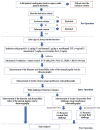Internal jugular distensibility index as a predictor of fluid responsiveness in adult patients undergoing elective surgery - A prospective accuracy study
- PMID: 40160910
- PMCID: PMC11949394
- DOI: 10.4103/ija.ija_457_24
Internal jugular distensibility index as a predictor of fluid responsiveness in adult patients undergoing elective surgery - A prospective accuracy study
Abstract
Background and aims: Assessing the intravascular volume is necessary in patients undergoing surgery, but predicting how the body will respond to fluid can be challenging. Evaluation of the internal jugular vein distensibility index (IJV-DI) is an alternative method to determine intravascular volume status. This study aims to determine the suitability of measuring stroke volume by using IJV-DI measurement compared with transthoracic echocardiography in assessing the fluid responsiveness in elective surgery patients.
Methods: This prospective study involved 79 subjects undergoing elective surgery under general anaesthesia. Following anaesthesia induction, IJV-DI and stroke volume measurements were performed before and after fluid administration. Subjects experiencing an increase in stroke volume of more than 10% were categorised as responders. The primary outcome was the suitability of IJV-DI in determining fluid responsiveness compared to transthoracic echocardiography in elective surgery patients. The data were then analysed to assess its diagnostic value using the receiver operator characteristic (ROC) curve, the appropriate cut-off point using the Youden index, and the correlation using Spearman's correlation test.
Results: A total of 45 subjects were responders. Our analysis revealed an area under the curve (AUC) value of 0.871 (95% CI: 0.790, 0.951). The optimal cut-off value was found at an internal jugular vein distensibility index of >12.62% with a sensitivity of 84.4% and a specificity of 79.4%. A moderate positive correlation existed between the index and stroke volume increase (r = 0.535, P < 0.001).
Conclusion: IJV-DI assessment is compatible with transthoracic echocardiography stroke volume measurement for evaluating elective surgery patients' fluid response.
Keywords: Echocardiography; fluid therapy; general surgery; internal jugular vein distensibility index; jugular veins; stroke volume; ultrasonography.
Copyright: © 2025 Indian Journal of Anaesthesia.
Conflict of interest statement
There are no conflicts of interest.
Figures



Similar articles
-
Jugular vein distensibility predicts fluid responsiveness in septic patients.Crit Care. 2014 Dec 5;18(6):647. doi: 10.1186/s13054-014-0647-1. Crit Care. 2014. PMID: 25475099 Free PMC article.
-
The Assessment of Intravascular Volume with Inferior Vena Cava and Internal Jugular Vein Distensibility Indexes in Children Undergoing Urologic Surgery.J Invest Surg. 2018 Dec;31(6):523-528. doi: 10.1080/08941939.2017.1364806. Epub 2017 Sep 27. J Invest Surg. 2018. PMID: 28952826
-
Internal jugular vein collapsibility does not predict fluid responsiveness in spontaneously breathing patients after cardiac surgery.J Clin Monit Comput. 2023 Dec;37(6):1563-1571. doi: 10.1007/s10877-023-01066-6. Epub 2023 Aug 12. J Clin Monit Comput. 2023. PMID: 37572237
-
Internal jugular vein ultrasound for the diagnosis of hypovolemia and hypervolemia in acutely ill adults: a systematic review and meta-analysis.Intern Emerg Med. 2022 Aug;17(5):1521-1532. doi: 10.1007/s11739-022-03003-y. Epub 2022 Jun 20. Intern Emerg Med. 2022. PMID: 35718838
-
Diagnostic accuracy of stroke volume variation for predicting fluid responsiveness in children undergoing cardiac surgery: A systematic review and meta-analysis.Paediatr Anaesth. 2021 Jul;31(7):755-762. doi: 10.1111/pan.14195. Epub 2021 May 11. Paediatr Anaesth. 2021. PMID: 33882623
References
-
- Shin CH, Long DR, McLean D, Grabitz SD, Ladha K, Timm FP. Effects of intraoperative fluid management on postoperative outcome: A hospital registry study. Ann Surg. 2018;267:1084–92. - PubMed
LinkOut - more resources
Full Text Sources
